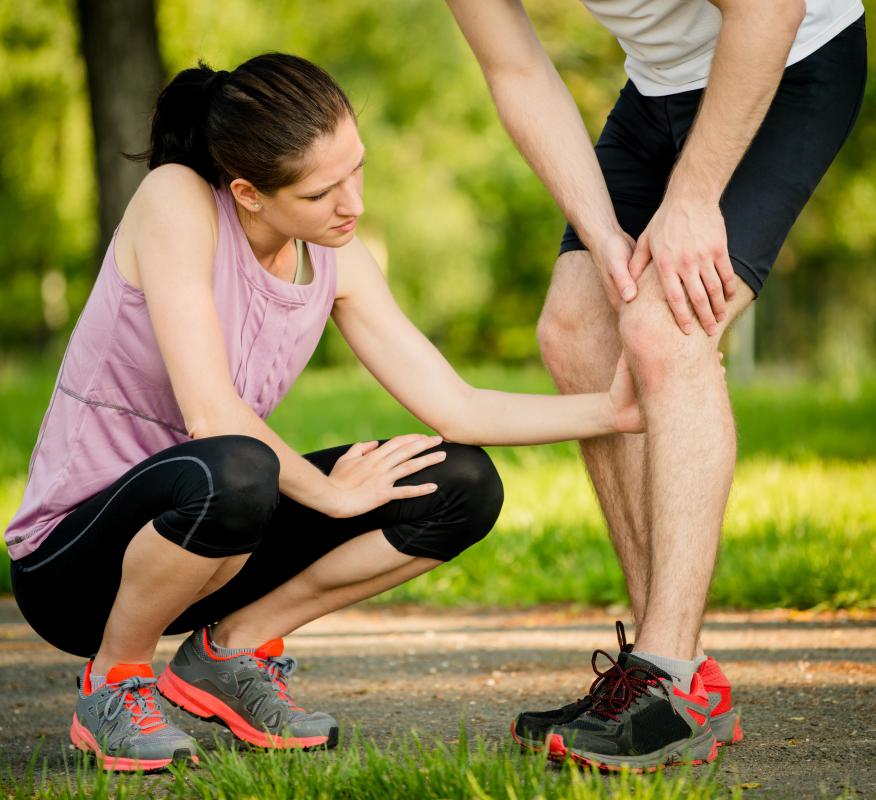At WiseGEEK, we're committed to delivering accurate, trustworthy information. Our expert-authored content is rigorously fact-checked and sourced from credible authorities. Discover how we uphold the highest standards in providing you with reliable knowledge.
What are the Different Types of Shin Splint Exercises?
The term "shin splints" can refer to several conditions in the lower leg that result in pain in that region of the body, and since the causes of shin splints vary from case to case, the different remedies will vary. Shin splint exercises can help strengthen the lower legs, however, essentially reducing the likelihood that shin splints will occur. Stretches are perhaps the most important shin splint exercises one can do both before and after physical activity, while strengthening shin splint exercises can address some of the causes of the pain. Sometimes shin splints are caused by other factors such as low quality footwear or foot pronation, and those issues will need to be addressed accordingly, regardless of the exercises one does.
Simple stretches should be a part of any routine of shin splint exercises. Such stretches keep the muscles of the leg limber and prepared for strain. Stretching the entire leg can help prevent shin splints, so stretches should not be limited to just the calves, shins, and feet. Sometimes shin splints are caused by compressed nerves in the legs, so stretching all leg muscles can help prevent nerve compression due to tight muscles. Ensuring all muscles of the leg are limber further reduces the likelihood that injuries can occur anywhere in the leg, which means a runner or athlete is less likely to make changes to his or her gait that can result in pronation or other motions that cause pain.

Strength training shin splint exercises can be done by sitting in a chair and crossing one leg over the other so the ankle of one leg rests on the knee of the other. One should begin by placing a hand on the foot around the big toe and pressing downward. At the same time, press upward with the foot against the pressure of the hand. Hold this position for several seconds, then release and repeat. Do the same exercise with the other foot as well. While in the same position, place the hand underneath the foot and press up against the foot near the smallest toe. At the same time, press downward with the foot against the pressure of the hand. Another exercise can be done by placing the hand on top of the foot across all toes, pressing downward with the hand, and pressing upward with the foot.

Other shin splint exercises can be done with a resistance band; the band can be used to move the foot in much the same fashion as the exercises already described. Calf strengthening exercises should also be done, as weak or tight calf muscles can lead to shin splints as well.
AS FEATURED ON:
AS FEATURED ON:












Discussion Comments
@pleonasm - Shin splints are often caused by inflammation, so it might help to take an anti-inflammatory after you finish exercising as well.
Just don't get into the habit of doing this, or take one before you start exercising. You really don't want to mask the pain, as it's a signal from your body that it's time to slow down or stop.
@Iluvaiporos - I absolutely hate shin splints but I always seem to get them when I'm starting back up a running routine, even if I've been stretching and doing exercises in the meantime.
I've found the only thing that really helps me is to just ease back into running as gradually as I can and stop whenever I feel the shin splints pain.
I've heard that swimming can help as well, but I've never really tried that as a way of controlling shin splints. I guess it makes sense as the water would help to support your limbs as you exercise.
One really good exercise for your lower legs is to simply raise and lower yourself on tiptoes as slowly as possible. If it feels too easy, try standing on the edge of a step and lowering your heels below it. It won't clear up shin splints right away but after a couple of weeks you should get much less shin splint pain. Just don't overdo it, as shin splits tend to get worse if you push yourself too much with them.
Post your comments